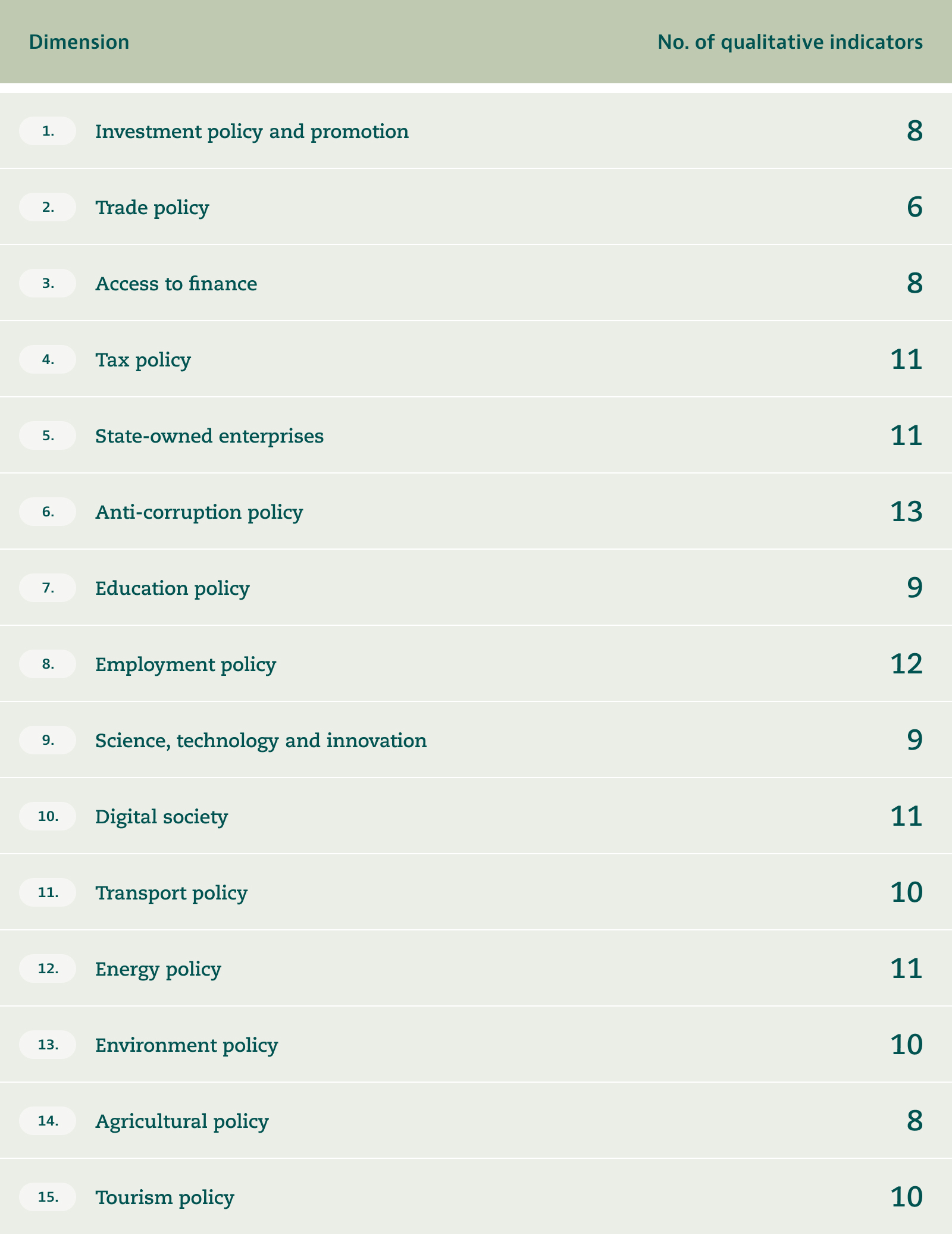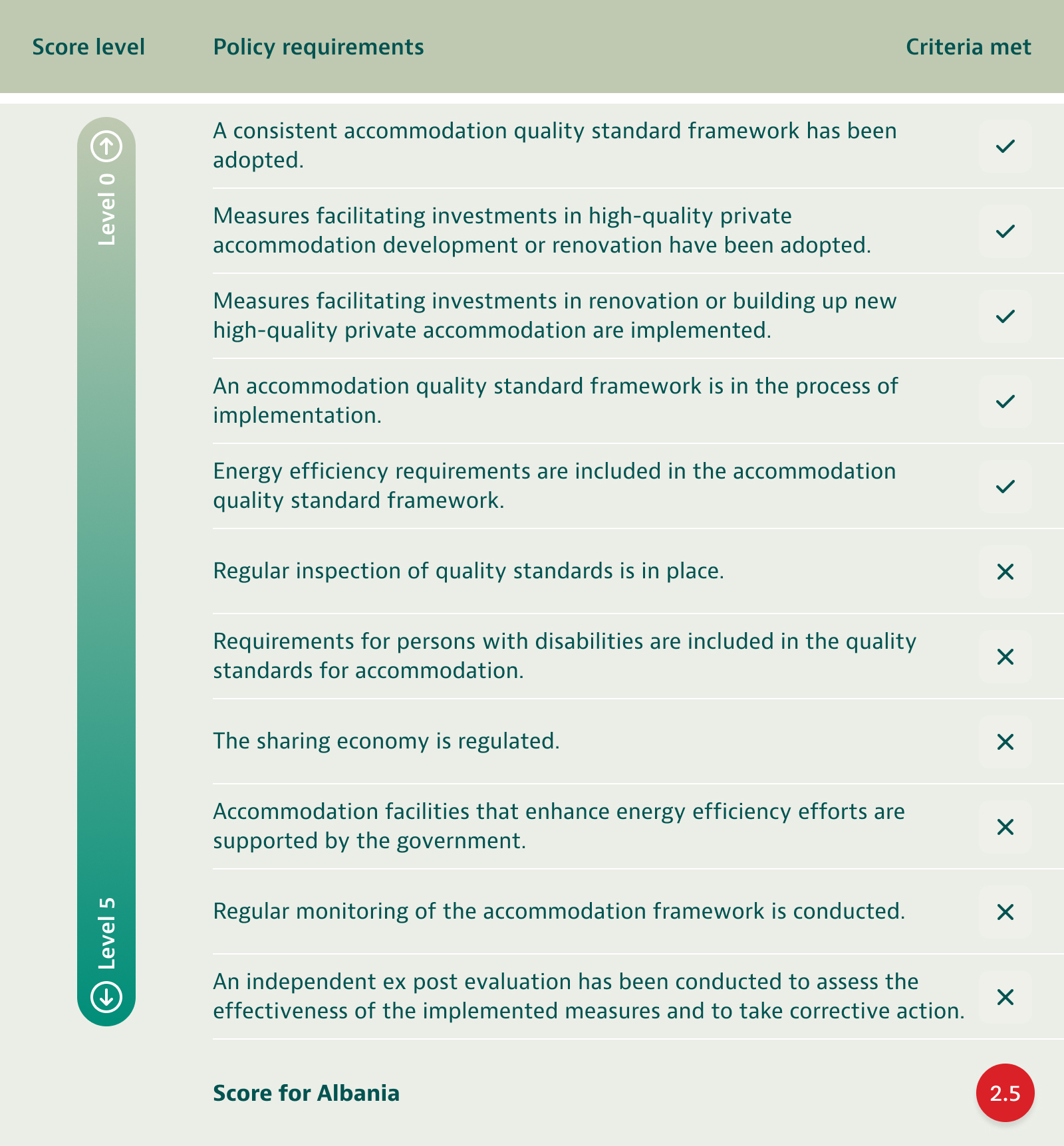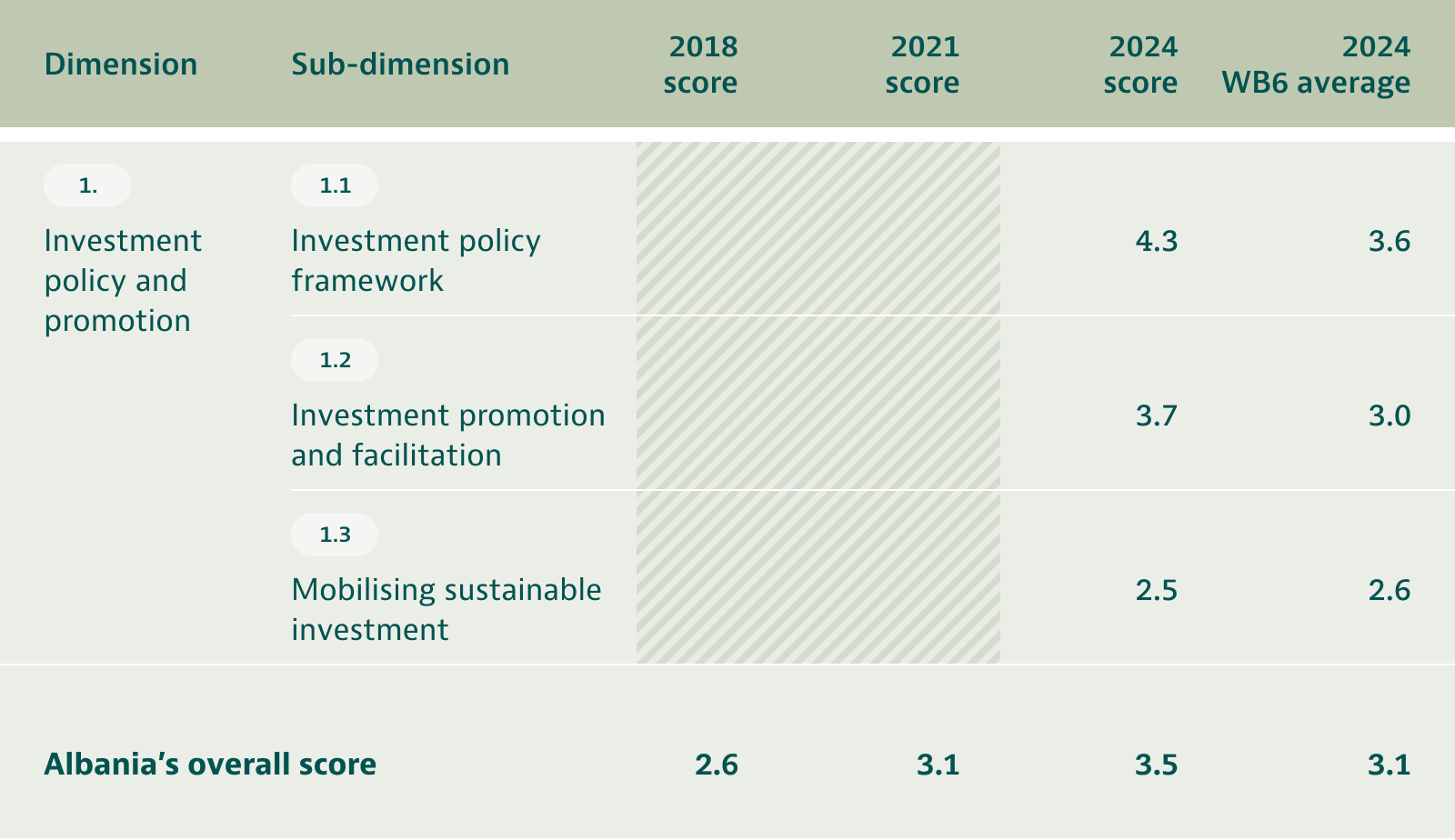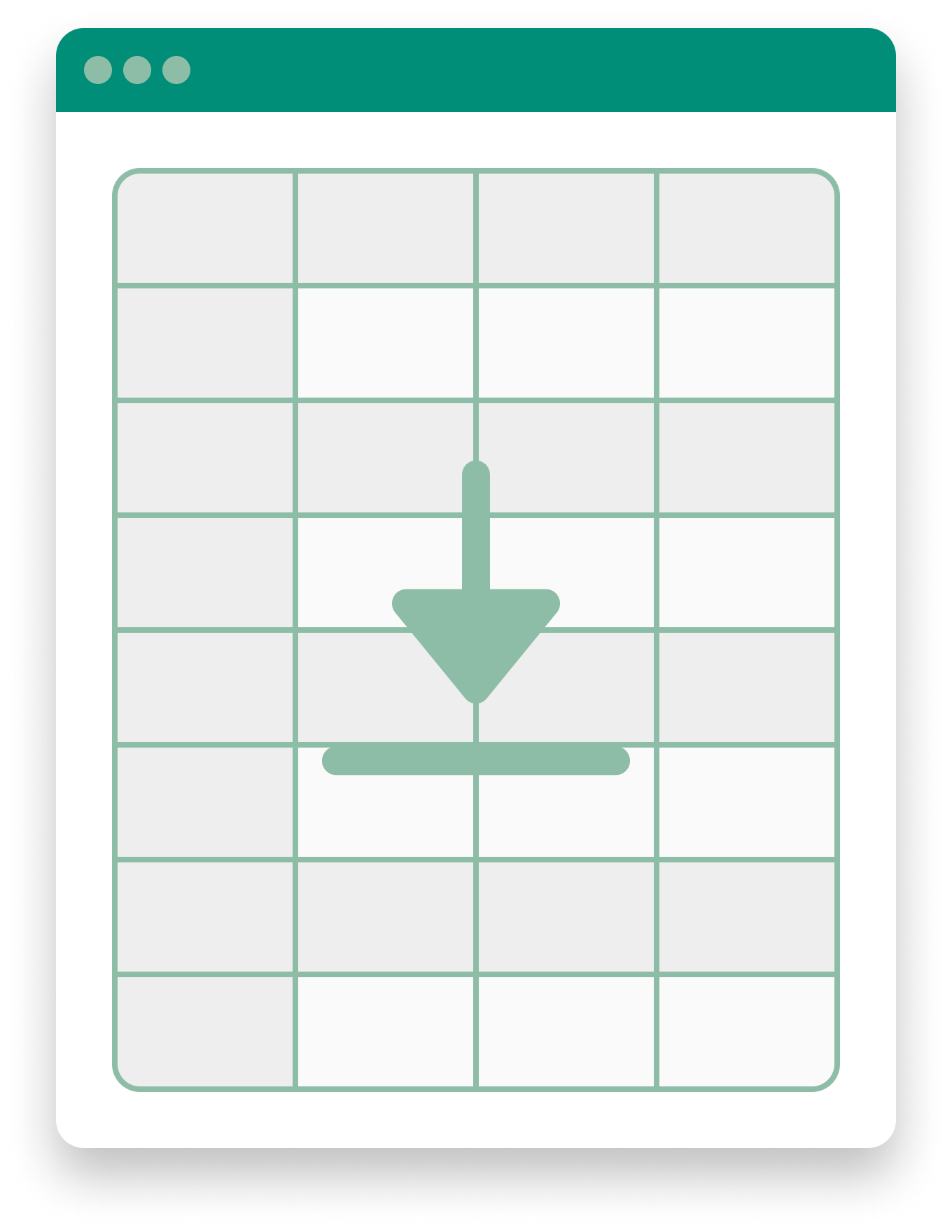Overall assessment approach
Each policy dimension is divided into several sub-dimensions that highlight its key elements. The sub-dimensions in turn are composed of qualitative and quantitative indicators that capture the design, implementation and performance of policies, processes and institutions.
The indicators in the Competitiveness Outlook’s 2021 edition were taken as a basis for the 2024 assessment and further updated to capture the latest policy developments, trends and OECD/EU standards and good practices. New qualitative and quantitative indicators were also introduced in some cases to capture developments in emerging policy areas. The full set of indicators used for each of the 15 policy dimensions can be found in the Policy Dimensions page of the Data hub.

Scoring structure of qualitative indicators
The methodology consists of assessing 147 qualitative indicators across the 15 policy dimensions presented in the table below. The 265 quantitative indicators also provide insights into the outcomes and performance of policies, demonstrating whether policies bring out the desired results and the extent to which they help to achieve the Western Balkans’ socio-economic convergence with the OECD and EU. However, although quantitative indicators provide insights and data that are essential for this comparison, they are not scored. Rather, qualitative indicators form the basis for the scoring and narrative of the publication.
Policy dimensions and indicators

Qualitative indicators focus on the development, implementation and comprehensiveness of policies in the Western Balkan economies. They assess all parts of the policy cycle including design, implementation, and monitoring and evaluation. The 2024 assessment retains the 0-5 scoring scale from previous cycles. However, the scoring criteria have been revised to reflect current good practices and policy trends in OECD and EU countries, as well as policy developments in the Western Balkans.
Each indicator is assigned a numerical score ranging from 0 to 5 based on the level of policy development, implementation, and monitoring and evaluation, enabling performance comparison across economies and over time. Level 0 represents the weakest performance, while Level 5 indicates the strongest, signifying more developed policies across all sections of the policy cycle, as well as a higher level of policy convergence towards OECD and EU good practices and standards.
For this cycle, the scoring of qualitative indicators has been refined to reflect the comprehensiveness and content of policies, aspects which were previously captured in the narrative but not explicitly considered for scoring. Scoring criteria were developed for each qualitative indicator to reflect both the sophistication and comprehensiveness of policies. Each criterion met on the scale of Level 0 to Level 5 indicates a level of policy sophistication and includes aspects related to the comprehensiveness of policies. This form of scoring allows for more nuanced score progression along the scale and incorporates more refined inputs in scoring.
0
Level
- No framework (e.g. law, institution, project, initiative) exists addressing the policy topic concerned
1
Level
- Existing draft or pilot policy framework with signs of government activity addressing the policy area concerned
2
Level
- Framework specifically addressing the policy area concerned is solidly in place, officially adopted by the government or parliament (where applicable)
- The framework includes policy features which are necessary to make it impactful
3
Level
- Level 2 plus some concrete indications that the policy framework is effectively being implemented
4
Level
- Level 3 plus evidence that the framework is monitored and, if necessary, adjusted accordingly
5
Level
- Level 4 plus independent impact evaluation
- Results of monitoring and impact evaluation inform policy framework design and implementation updated towards OECD good practice
For this assessment cycle the OECD team also prepared simplified versions of the scoring methodology using benchmark criteria to better illustrate the reasoning and rationale behind the scores, and to facilitate the comparison of progress made and room for improvement between different Western Balkan economies in a visually friendly and accessible way. However, it is only a simplified representation and does not encompass all the elements that influence scoring. The table below presents an example indicator for accommodation quality (Tourism policy) for Albania, with assessed criteria in the second column. Please note that the table is solely for demonstration and does not reflect the criteria met or final score for Albania.
Competitiveness Outlook scoring system: Sample indicator – accommodation quality

Note: The indicator and criteria shown do not reflect the actual score for Albania and are included solely for demonstration purposes. In other words, each criterion does not directly correspond to a score increase, but consideration was given to aligning the overall achievement of criteria when assigning the final score.
The Policy Dimensions page has the scores for every indicator, showcasing the fulfilment of criteria by each economy and offering the rationale behind the scores. Scores can be explored within each policy dimension, as well as compared over time and between the Western Balkan economies.
The final scores represent a simple average of all indicators, rather than individual sub-dimensions. Scores for indicators and sub-dimensions are not weighed as different indicators can have different levels of importance for different stakeholders. The table below illustrates the dimension scoring system and thus the final scores. The number of indicators included in each sub-dimension varies depending on the complexity and scope of the policy area. Therefore, the sample average of the sub-dimension scores can be different to the final dimension scores.
Competitiveness Outlook scoring system: A sample presentation of dimension scores

Regional policy clusters
In order to focus the narrative of the Western Balkans Competitiveness Outlook regional publication on the key issues the region is facing in boosting economic competitiveness and accelerating economic convergence with the EU, the OECD has created five distinct policy clusters composed of qualitative and quantitative indicators that make up the 15 policy dimensions: 1) Infrastructure and connectivity; 2) Skills; 3) Business environment; 4) Digitalisation; and 5) Greening. The clusters are intended to be thematic and mutually complementary, enabling key stakeholders to identify the main areas of progress and key challenges at the regional level across several areas.
More information about the policy dimensions and indicators that make up each regional policy cluster can be found in the Themes page of the Datahub.
For more information on the region’s progress in accelerating convergence with the EU please see the OECD’s Economic Convergence Scoreboard, as well as the dedicated convergence chapter of the regional publication.
Limitations of the assessment methodology
The Western Balkans Competitiveness Outlook 2024 possesses a number of strengths which make it a uniquely valuable tool for Western Balkan policy makers, citizens, researchers, and investors and international donor organisations. However, there are also inevitable limitations:
- While the assessment covers 15 policy areas crucial for economic competitiveness, it does not exhaustively address all areas that impact competitiveness.
- The same assessment framework was applied for all economies to benchmark and compare performance, which means that certain economy-specific characteristics and factors might not be fully reflected in the scoring.
- Data collection on certain (quantitative) indicators is limited in the region, which means that data are not always comprehensive and exhaustive for all indicators.
- The comparability of assessment scores with previous editions is limited to a degree due to methodological changes and updates to the assessment framework. Comparability with the first edition (2016) is not possible due to significant methodological differences.
- The publication focuses on the main elements and aspects of reforms important for the Western Balkan economies and the region, but does not exhaustively cover all developments that took place during the assessment period.

